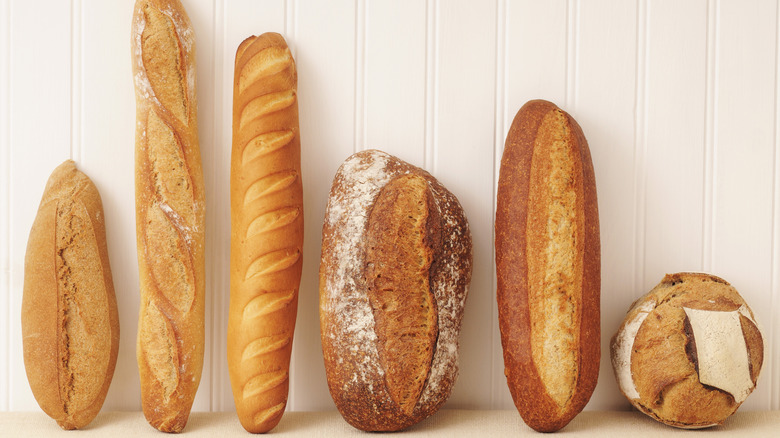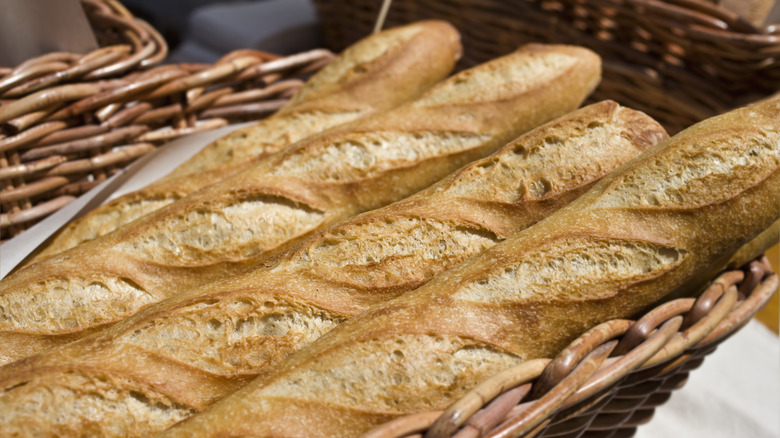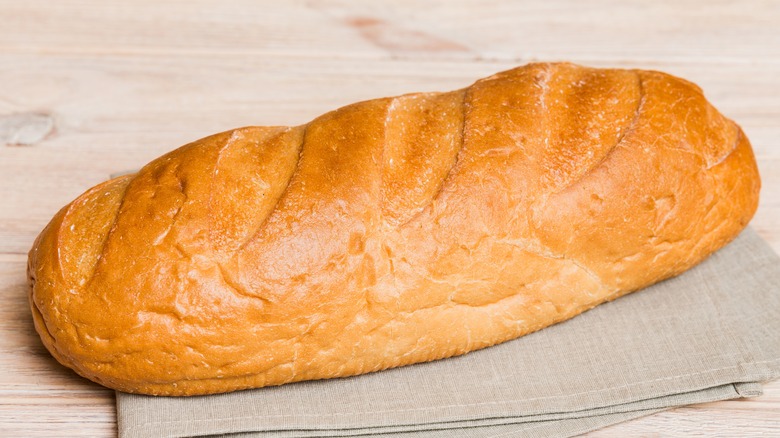French Bread Vs Baguette: What's The Difference?
In the words of the great Oprah Winfrey, "I love bread." From round loaves of sourdough to intricately braided challah and crispy baguettes, bread is enjoyed around the world in many different forms. But when you're shopping for the loaf that best suits your needs, it can be difficult to distinguish the differences between certain kinds. For example, French bread and baguettes are, surprisingly, not the same thing. While both are on the longer side and typically made of white bread, they actually have a lot less in common than you might assume. Accidentally picking one when you meant to snag the other could result in a very different outcome for your recipe.
Ironically enough, the bread with "French" in its name is actually not, in fact, French in origin. When baguettes and French bread are compared side by side, the differences in size and texture become clear. French bread is typically softer, shorter, and wider than baguettes, which are long, thin, and noticeably hard on the exterior. The two types of bread are also used differently across various cuisines, thanks to their contrasting consistencies in both crumb and crust.
There are strict laws about how baguettes must be prepared
The word baguette is French for "stick," which feels especially apt when compared to the softer, wider loaves of French bread. The size of a baguette can range from 26 to 39 inches, practically one entire meter's worth of bread. While the exact proportions don't have to be precise for it to be legally considered a baguette, the recipe and preparation style do.
The French government does not mess around when it comes to authentic baguette-making. According to a law passed in 1993, baguettes can only be made with four ingredients: wheat flour, water, salt, and yeast. No additional additives or flavorings are allowed, and the bread must be made in-house by the establishment selling it. Additionally, the dough cannot be drastically altered by temperature, resulting in a bread with a very limited shelf life.
Keeping baguettes fresh for longer than two days can be challenging, but the slightly stale crunch they develop is often preferred for dipping into soups, sauces, olive oil, or spreading with some soft butter. Baguettes are pretty synonymous with French culture, but this tasty loaf is just one of many types of bread you'll find in authentic French bakeries. One bread you won't typically find in these establishments, however, is American French bread.
French bread is actually American
Despite its name, loaves labeled "French bread" in most grocery stores are actually made in the United States. While this bread may have been influenced by traditional French bakery items like baguettes, the French bread we know today has very distinct characteristics.
When you handle a loaf of American French bread, you'll notice the thin crust easily bends, giving way to the thick, soft dough found on the inside. This type of dough is not typically fermented or steam-injected during baking, resulting in a texture closer to brioche than to a traditional baguette. While its softness and density make it less ideal for dipping and spreading, there are plenty of recipes that are elevated by using French bread.
For example, a classic stack of French toast made with French bread perfectly retains the sweet, eggy batter. The thick yet airy dough is also the perfect base for French bread pizza topped with sauce, cheese, and toppings galore.



